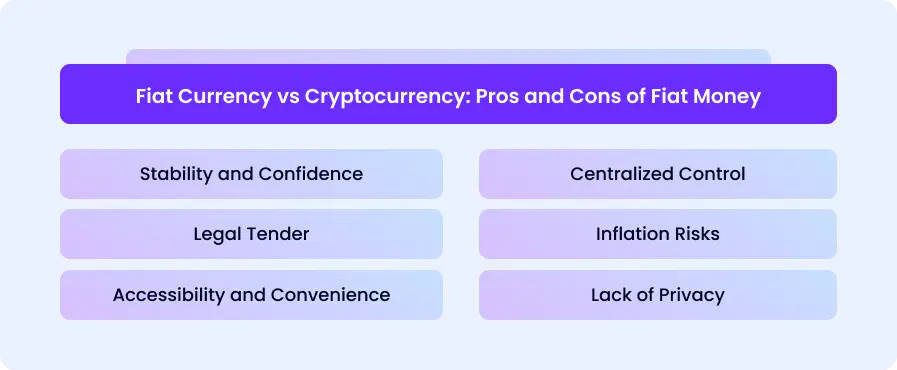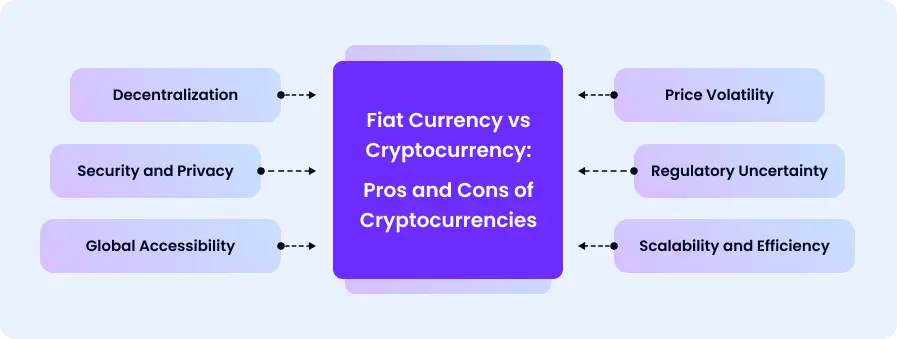Fiat Currency vs Cryptocurrency: the Meaning of Fiat Money and Crypto in a Changing Financial Paradigm
The evolution of digital technologies has transformed the way we conduct financial transactions, giving rise to the emergence of cryptocurrencies as a new form of decentralized currency. While crypto assets have garnered significant attention in recent years, the question of their coexistence alongside traditional fiat money remains a topic of debate. In this article, we delve into the world of fiat money and explore its pros and cons, shedding light on the ongoing relationship between fiat currencies and their digital counterparts.
What is Fiat Money? Fiat currency definition
The definition of fiat money is the currency that is issued and regulated by a government or central authority, typically in the form of banknotes and coins. Unlike commodity-based money, such as gold or silver, fiat money has no intrinsic value and is not backed by a physical asset. Its value is derived from the trust and confidence placed in the issuing authority, as well as the belief that it can be exchanged for goods, services, and other assets.
Fiat currencies serve as a medium of exchange, facilitating economic transactions within a specific jurisdiction. They are widely accepted as legal tender for the settlement of debts, taxes, and the purchase of goods and services. The authority responsible for issuing and controlling the supply of fiat money often employs monetary policies to manage inflation, stabilize the economy, and promote financial stability.
Fiat Currency vs Cryptocurrency: Pros and Cons of Fiat Money
Fiat money offers several advantages that have contributed to its widespread adoption.
Stability and Confidence
Governments and central banks play a crucial role in ensuring the stability of fiat currencies. Through monetary policies, they can regulate interest rates, control inflation, and maintain overall economic stability. The established trust in fiat money provides confidence to businesses and consumers alike, fostering economic growth.
Legal Tender
Fiat currencies enjoy the status of legal tender, meaning they must be accepted for payment of debts. This attribute ensures the seamless functioning of financial systems and facilitates the exchange of goods and services within a particular jurisdiction.
Accessibility and Convenience
Fiat money is universally accepted and easily accessible to the general public. Physical cash, in the form of dollar bills and coins, remains a familiar and convenient means of payment, particularly for small transactions or situations where electronic payment options are limited.
However, fiat money also presents certain drawbacks.
Centralized Control
The centralized nature of fiat money places significant control in the hands of governments and central banks. This control grants them the power to influence the value and supply of money, but it also opens the door to potential mismanagement, corruption, or political interference.
Inflation Risks
Fiat currencies can be susceptible to inflationary pressures, particularly when governments excessively increase the money supply or fail to implement effective monetary policies. Inflation erodes the purchasing power of money over time, meaning the reduction of the savings value and potentially disrupting economic stability.
Lack of Privacy
The use of fiat money often involves the need for financial intermediaries, such as banks, which can compromise the privacy and anonymity of transactions. Traditional financial systems require personal identification and record-keeping, which may impede individuals seeking more privacy in their financial transactions.
As the financial landscape continues to evolve, crypto assets have emerged as an alternative to fiat money, offering their own unique advantages and disadvantages. In the subsequent sections, we will explore the rise of crypto assets and delve into the coexistence of these digital currencies alongside fiat money.

What are Cryptocurrencies?
Cryptocurrencies, often referred to as digital or virtual currencies, or simply crypto, are decentralized digital assets that utilize cryptography for secure financial transactions.
What makes cryptocurrency different from regular currency like the dollar? Unlike fiat money, crypto assets operate on a technology called blockchain, which is a distributed ledger that records all transactions across a network of computers, ensuring transparency and immutability.
Cryptocurrencies are typically created through a process called mining or issued through Initial Coin Offerings (ICOs). The most well-known and widely adopted crypto coin to date is Bitcoin, which was introduced in 2009. Since then, numerous other cryptocurrencies, including Ethereum, Ripple, and Litecoin, have entered the market, each with its own unique features and functionalities.
So, is crypto a fiat currency? Absolutely not, fiat currency refers to a currency that is issued and regulated by a government, such as the US dollar or the Euro. On the other hand, cryptocurrency is a digital or virtual form of currency that uses cryptography for security.
Fiat Currency vs Cryptocurrency: Pros and Cons of Cryptocurrencies
Cryptocurrencies offer several key advantages.
Decentralization
One of the fundamental characteristics of cryptocurrencies is their decentralized nature. They operate on a peer-to-peer network, eliminating the need for intermediaries like banks or governments to facilitate transactions. This decentralized structure provides greater control and autonomy to individuals over their financial transactions.
Security and Privacy
Crypto assets employ robust cryptographic techniques to secure transactions and protect user identities. The use of public and private keys ensures secure and verifiable transfers, reducing the risk of fraud or hacking. Additionally, cryptocurrencies can offer enhanced privacy options, allowing users to maintain a certain level of anonymity in their transactions.
Global Accessibility
Cryptocurrencies have no geographic boundaries, enabling anyone with an internet connection to participate in transactions. This accessibility empowers individuals in regions with limited access to traditional banking services, facilitating financial inclusion and economic empowerment.
However, cryptocurrencies also pose certain challenges and drawbacks.
Price Volatility
The value of cryptocurrencies can exhibit high levels of volatility, often experiencing significant price fluctuations within short periods. This volatility can make cryptocurrencies less suitable as a stable store of value or a medium of exchange for everyday transactions.
Regulatory Uncertainty
The regulatory framework surrounding the crypto domain is still evolving, resulting in uncertainty and differing approaches across jurisdictions. The lack of standardized regulations can create challenges in terms of consumer protection, taxation, and anti-money laundering efforts.
Scalability and Efficiency
The underlying technology of cryptocurrencies, such as blockchain, can face scalability issues, particularly when faced with a large number of transactions. This can result in slower transaction times and higher fees compared to traditional payment systems, hindering their widespread adoption for everyday transactions.

What is Fiat in Crypto?
What does fiat mean in crypto? In the context of cryptocurrency, the term "fiat" refers to traditional government-issued currencies that are not backed by a physical commodity like gold or silver. Fiat currencies derive their value from the trust and confidence people have in the government that issues them and the belief that others will accept them as a medium of exchange.
When discussing cryptocurrencies, fiat is often contrasted with digital currencies like Bitcoin, Ethereum, or other cryptocurrencies that operate independently of any central authority. And the answer to the question “What is the opposite of cryptocurrency” is fiat.
Can Cryptocurrencies Replace Fiat Money?
The question of whether cryptocurrencies can replace fiat money entirely is a complex and highly debated topic. While cryptocurrencies offer unique advantages, they also face significant challenges in becoming the sole form of currency. Several factors need to be considered:
Fiat vs Crypto: Acceptance and Adoption
For cryptocurrencies to replace fiat money, they must gain widespread acceptance and be adopted by businesses, governments, and the general population. While cryptocurrencies have witnessed significant growth and adoption in recent years, they still represent a fraction of the global financial system.
Fiat vs Crypto: Stability and Trust
Fiat money benefits from the stability and trust established over centuries of use, backed by governments and central banks. Cryptocurrencies, on the other hand, are relatively new and face hurdles in establishing the same level of trust and stability.
Fiat vs Crypto: Regulatory Framework
The development of a comprehensive regulatory framework for cryptocurrencies is crucial for their long-term viability and acceptance. Clear regulations can help address concerns related to security, fraud, money laundering, and investor protection, making cryptocurrencies more attractive to institutional investors and the general public.
Is crypto real money?
So, is crypto real money? Some people argue that cryptocurrencies can be considered a form of money by the definition, because they can be used to buy goods and services, and they possess certain characteristics of money, such as divisibility and fungibility. Additionally, some businesses and merchants accept cryptocurrencies as a form of payment.
However, others argue that cryptocurrencies do not meet all the criteria to be considered "real money" due to factors such as price volatility, lack of widespread acceptance, and regulatory challenges. Additionally, the lack of a central authority overseeing cryptocurrencies can lead to concerns about security, fraud, and money laundering.
Fiat vs Crypto: a direct comparison
To better understand the coexistence of fiat money and cryptocurrencies, it is essential to examine the key differences between these two forms of currency. The following table highlights the main distinctions.
Fiat currency vs cryptocurrency: a comparison table
| Fiat currency vs cryptocurrency: comparison features | Fiat Money | Crypto assets |
|---|---|---|
| Centralization | Centralized, controlled by government | Decentralized, peer-to-peer network |
| Backing | Backed by the issuing authority | No intrinsic backing or physical asset |
| Regulation | Subject to government regulations | Varied regulatory frameworks globally |
| Privacy and Anonymity | Limited privacy and transactional data | Enhanced privacy features and anonymity |
| Transaction Speed | Instantaneous | Variable, depending on network capacity |
| Scalability | Established systems for large volumes | Scalability challenges |
| Volatility | Generally stable | High volatility |
| Accessibility | Widely accepted, physical cash | Global accessibility via the internet |
| Trust and Acceptance | Established trust and acceptance | Growing acceptance, but still evolving |
| Financial Inclusion | Accessibility barriers for unbanked | Potential for greater inclusion |
| Security and Fraud | Established security measures | Robust cryptography for secure transfers |
Cryptocurrency vs cash: two sides of one coin?
It is important to note that the table above presents general characteristics and may not capture every nuance or exception within the vast and diverse landscape of fiat money and cryptocurrencies. Additionally, the comparison can vary based on the specific fiat currency and cryptocurrency being considered.
Fiat money, as the traditional form of currency like dollar or euro, is backed by governments and central authorities, offering stability and wide acceptance. It operates within established regulatory frameworks and provides accessibility through physical cash. However, it may lack certain privacy features and faces the risk of inflation.
On the other hand, cryptocurrencies operate on decentralized networks, leveraging cryptographic techniques to ensure security and privacy. They offer global accessibility, potential financial inclusion, and the opportunity for peer-to-peer transactions without intermediaries. However, cryptocurrencies face challenges regarding scalability, regulatory uncertainty, and price volatility.
Fiat Currency vs Cryptocurrency: Final Thoughts
The future of cryptocurrencies is a subject of intense speculation and debate. While their journey has been characterized by rapid growth, technological innovation, and increasing acceptance, challenges such as regulatory concerns, scalability issues, and price volatility still persist. However, the underlying principles of decentralization, security, and global accessibility that cryptocurrencies offer resonate with the evolving needs of the digital age. As governments, financial institutions, and individuals continue to explore the potential of cryptocurrencies, it is likely that we will witness further developments, advancements, and maturation in the space. Whether cryptocurrencies become an integral part of our financial systems or serve as a niche alternative, their impact on the way we transact, store value, and interact with money is undeniable. Time will reveal the extent to which cryptocurrencies shape the future of finance.



